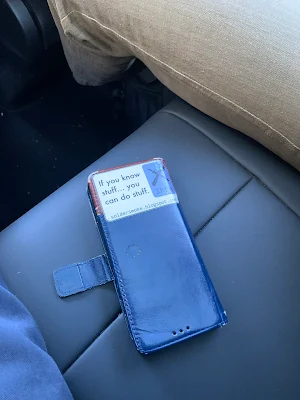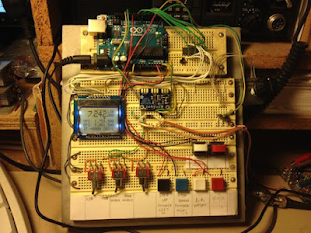Podcasting since 2005! Listen to Latest SolderSmoke
Friday, June 14, 2024
Greetings from Low Earth Orbit
Saturday, June 1, 2024
Farhan Talks Radio Tech at SolderSmoke HQ (EAST) (TWO VIDEOS!)
Wednesday, May 29, 2024
2014 "Off the Shelf" Regen Comes Off the Shelf (Two Videos)
Walter KA4KXX spotted an error in the schematic of my 2014 "Off the Shelf" regen receiver: The source resistor on the MPF-102 should be 2200 ohms, not 2.7 ohms. See:
https://soldersmoke.blogspot.com/2014/09/schematic-for-off-shelf-regen.htmlMonday, May 27, 2024
Ham Radio in China -- Interesting info from 高大伟 David Cowhig
David Cowhig (aka WA1LBP, aka Gao Da Wei) was Hambassdor for 73 Magazine on Okinawa when I held a similar "position" on the island of Hispaniola. David is a real Asia hand, and is fluent in both Mandarin and Japanese. He is uiniquely sitated to provide info on ham radio in China. In a recent post he provides this info, and describes how we may soon be hearing from ham Taikonauts in space:
https://gaodawei.wordpress.com/2024/05/22/2024-ham-radio-in-china-soon-chinese-hams-in-space/
Thanks David!
Sunday, May 26, 2024
A Really Cool Homebrew Computer
Saturday, May 25, 2024
Pete Juliano's Amazing Videos -- 318 of Them!
Friday, May 24, 2024
Version II of 15-10 Rig -- Updates on Bal Mod, AF amp, and RF Amp, DX
Version II of the 15-10 rig is mostly done. I did a lot of work on the AF amp, balanced modulator, Mic amp, carrier oscillator, and filter. Dean KK4DAS and I continue to test and measure the RF power amplifier. I describe the brutally simple, non-sequenced T/R switching arrangement, and the spread-out open air construction style.
Version I of this rig is on its way to the Dominican Republic. Version II will stay in Virginia. I have already worked a lot of SSB DX with this rig, including, Thailand, Taiwan, China, India, Kenya, Australia, American Samoa, and others.Thursday, May 23, 2024
Charlie ZL2CTM's New Receiver
Thanks Charlie! Be sure to check out the rest of his YouTube channel: https://www.youtube.com/@CharlieMorrisZL2CTM
Wednesday, May 22, 2024
Rigs on Vertical Boards -- Then and Now
Tuesday, May 21, 2024
Laser Communication in London 2007 -- a Pointer, a VW Solar Panel, and Radio Kismet
Friday, May 17, 2024
Band Imaging Rigs (Receivers and Transceivers) -- Video from WA7MLH
Thursday, May 16, 2024
A Light-beam QSO in Hollandia, Christmas 1944
Christmas, 1944
In a wartime world the singular and exclusive camaraderie that exists in the hobby of amateur radio results in so many unexpected and coincidental meetings between good friends, who have previously never seen each other, as to make such happenstance fairly commonplace. But I boast a tale in which time, place and circumstance combined to cause a similar occurrence to be most extraordinary.
The Liberty ship El Segundo Ruiz Belvis lay at anchor in the murky waters of Humbolt Bay, New Guinea, on a tepid tropical night in '44. In the absence of the moon, the Dipper and the Southern Cross scintillated bewitchingly. On the shore, the lights of the army base of Hollandia burned steadily in contrast to the varipowered signal blinkers which intermittently pieced the opaque darkness throughout the harbor. The latter were visual communication between ships and shore plus an admixture of ship-to-ship chatter, official and otherwise. There was an underlying tense tinge to the atmosphere and the stillness was broken only by the sharp staccato of the Belvis' blinker shutters as the signalman transacted port business with the powerful land station.
This was rendezvous. Our Liberty, with scores of army personnel aboard, had here become a unit in the formation of a huge convoy. Crammed into holds, on hatches and into every available nook and cranny of the steel deck, we were Leyte-bound. Stifled, sweaty and hungry on our two meals per day, we wore out deck after deck of pinochle cards and read every available piece of literature over and over again. It was almost a month since we had left Sansapor, scene of our last operation. We were exuberant in the knowledge that we were soon to leave New Guinea.
Christmas was but a few days away and we had had no mail for weeks. Men leaned languidly on the rail and thought of home while others dreamed of the same in their cramped quarters. The circumstances certainly made this Yuletide one to be long remembered. Nevertheless, all that would feature this day for us would be a possible piece of priceless turkey added to the usual dehydrated viands. Just another dragging equatorial day to be piled atop hundreds of others like it.
It was ten o'clock. I was wide awake; only my eyes were tired. Presently, I found myself detachedly reading the blinkers which poked their focused fingers indiscriminately about the bay. My quarters, in the cab of a 399, were on the port rail amidships and afforded a good view across the water. I became absorbed in various bits of chatter between nearby vessels. It struck me that QRM was quite heavy tonight—a sort of an optical 80 meters. I saw one of the lights sign off with a "73." This was interesting as among the host of merchant marine signalmen, hams are spread pretty thinly. I seized my M-1 torch and focused an insipid beam in the direction of that ship. I sent CQ CQ CQ K. A ham call sign is a cumbersome thing to handle with a blinker. Furthermore, I had no faith in the DX powers of my 3-volt flashlight bulb. I was therefore elated when a bright interrogatory sign beamed forth, aimed obviously in my direction. Contact! True, it was outside the hambands, but band divisions in the microwave region are indefinite anyway.
I was still dubious as to whether my man was an amateur. Rather than complicate matters immediately, at this speed of 8 words per minute, I began in the language of the layman: HELLO PAL WHERE YOU FROM? K. Back in an agreeably rhythmic style came: R TULSA OKLA NAME IS HAL K. The given name and place struck a subconscious inner chord vaguely. Next, I blinked: GE HAL IM ROD FROM CHGO K. There was a pause. He reoriented his beam to compensate for tidal drift and then startled me with: W9BRD DE W5EGA K.
The night quickly took on an exhilarant aspect as we lapsed into ham vernacular, spiced with many Morse slaps on the back. Hal Frank was no other than an old c.w. crony of mine. We had heckled each other on 80, 40 and 20 a countless number of times in the prewar days. In memory I was hearing again that beautiful swing and T9X sledge-hammer signal off his three-element rotary. We discovered mutual ham friends and we exchanged much welcome information and recounted bygone days. He was quite amazed to learn that I was behind a mere GI flashlight (with low batteries at that). The QSO continued far into the night—the next and the next.
We seemed destined to rot in our anchorage. The convoy movement was postponed from day to day. However, this Christmas season took on a much different aspect for me as arrangements were made and, at 0900 Christmas Day, my friend, Wilbur Kuure, W9YNY, and I debarked unsteadily down the ladder and made our way across an undulating swell to the Liberty ship Chittenden. There, we met Lt. Hal Frank, W5EGA, personally, for the first time. We all agreed that it was quite a small and bizarre world that December 25th.
Verbal reminiscences cluttered the air within W5EGA's exceedingly neat cabin for several hours. Shelves in his quarters were lined with excellent reading material including many late QSTs. Compared to our situation aboard the Belvis, Kuure and I thought this a bit of heaven.
We were thoroughly acquainted by the time we appeared in the officers' mess. As the cuisine took shape before us and disappeared into our eager gullets, my army pal and I felt somewhat sorry for our less fortunate buddies on the home ship. But such is life. We had, in nautical terms, a "Little Roundhouse," consisting of a generous helping of everything on the menu. We swept our plates clean to Hal's amusement. I remember, most distinctly, the dessert of apple pie and ice cream.
Nightfall found Kuure and me "back to earth" on the Belvis after a most delightful Christmas Day. According to plan, we blinked a "goodnight and thank you" to W5EGA through the twilight. That was our last QSO of that series. Not long after that we weighed anchor and headed for our next stop on the long road back home. Our holiday was over, a new year had begun and there was still a war to be won.
| From S/Sgt. R. H. Newkirk, W9BRD, "Christmas, 1944" QST, January 1946, pages 25 and 102. |








































